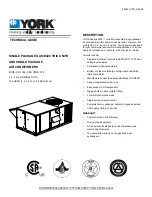
34
ENGLISH
WARNING
!
• Follow ordinance of your governmental organization for
technical standard related to electrical equipment, wiring
regulations and guidance of each electric power company.
• Make sure to use specified cables for connections so that no
external force is imparted to terminal connections. If
connections are not fixed firmly, it may cause heating or fire.
• Make sure to use the appropriate type of overcurrent protection
switch. Note that generated overcurrent may include some
amount of direct current.
Field Wiring
208/230 V
Example Connection of Communication Cable
1 Outdoor Unit-3 Ø, 208/230 V
Switch
ELCB
Communication Line
(2 Wires Cable)
Power Line
(3 Wires Cable)
Communication Line
(3 Wires Cable)
Power Line
(2 Wires Cable)
Power Line
ELCB
(2 Wires Cable)
Power Line
(2 Wires Cable)
Power Line
(2 Wires Cable)
Power Line
(2 Wires Cable)
[Outdoor Unit]
[Indoor Units]
Power supply
3 Phase 3 Wires
60 Hz 208/230 V
Power supply
1 Phase 60 Hz
208/230 V
(Main Switch)
Pull box
(Installer option)
Pull box
(Installer option)
Pull box
(Installer option)
HR unit
L(L1) N(L2)
R(L1) S(L2) T(L3)
2 Outdoor Units-3 Ø, 208/230 V
When the power source is connected In series between the units.
When the power source is supplied to Each outdoor unit individually.
Communication Line
(2 Wires Cable)
Power Line
(3 Wires Cable)
Communication Line
(3 Wires Cable)
Power Line
(2 Wires Cable)
Power Line
(2 Wires Cable)
(2 Wires Cable)
Power Line
(2 Wires Cable)
Power Line
(2 Wires Cable)
[Master]
[Indoor Units]
(Main Switch)
[Slave]
Pull Box
(Installer option)
Pull Box
(Installer option)
Pull Box
(Installer option)
Pull Box
(Installer option)
nication L
es Cable
Com
Power
(2 Wires
(2 Wires C
r Line
(2 Wires Cab
[Master]
[Sla
Power L
Wire
Power supply
3 Phase 3 Wires
60 Hz 208/230 V
Power supply
1 Phase 60 Hz
208/230 V
R S T
Switch
ELCB
ELCB
L(L1) N(L2)
Power Line
Switch
Communication Line
(2 Wires Cable)
Power Line
(3 Wires Cable)
Communication Line
(3 Wires Cable)
Power Line
(2 Wires Cable)
Power Line
(2 Wires Cable)
Power Line
(2 Wires Cable)
Power Line
(2 Wires Cable)
[Master]
[Indoor Units]
Power supply
3 Phase 3 Wires
60 Hz 208/230 V
Power supply
1 Phase 60 Hz
208/230 V
(Main Switch)
[Slave]
Switch
ELCB
ELCB
Pull box
(Installer option)
Pull box
(Installer option)
Pull box
(Installer option)
Power Line
(2 Wires Cable)
HR unit
ELCB
L(L1) N(L2)
R(L1) S(L2) T(L3)
R(L1) S(L2) T(L3)
HR unit
3(A) 4(B)
3(A) 4(B)
3(A) 4(B)
3(A) 4(B)
A
B
Master
Outdoor Unit
SODU. B SODU. A
IDU. B
IDU. A
CEN. B
CEN. A
DRY1
DRY2
GND
12 V
Between Indoor and Master Outdoor unit
WARNING
!
• Indoor unit ground lines are required for preventing electrical shock
accident during current leakage, Communication disorder by noise
effect and motor current leakage (without connection to pipe).
• Don't install an individual switch or electrical outlet to disconnect
each of indoor unit separately from the power supply.
• Install the main switch that can interrupt all the power sources in an
integrated manner because this system consists of the equipment
utilizing the multiple power sources.
• If there exists the possibility of reversed phase, lose phase,
momentary blackout or the power goes on and off while the
product is operating, attach a reversed phase protection circuit
locally. Running the product in reversed phase may break the
compressor and other parts.
• When using shielded wires, perform a single-point grounding only
to the outdoor unit for grounding of communication wires.
CAUTION
!
• All installation site must require attachment of an earth leakage
breaker. If no earth leakage breaker is installed, it may cause an
electric shock.
• Do not use anything other than breaker and fuse with correct
capacity. Using fuse and wire or copper wire with too large capacity
may cause a malfunction of unit or fire.
Wiring of main power supply and equipment
capacity
- Use a separate power supply for the Outdoor Unit and Indoor Unit.
- Bear in mind ambient conditions (ambient temperature,direct
sunlight, rain water,etc.) when proceeding with the wiring and
connections.
- The cable size is the minimum value for metal conduit wiring. The
power cord size should be 1 rank thicker taking into account the line
voltage drops. Make sure the power-supply voltage does not drop
more than 10 %.
- Specific wiring requirements should adhere to the wiring regulations
of the region.
- Power supply cords of parts of appliances for outdoor use should not
be lighter than polychloroprene sheathed flexible cord.
- Don't install an individual switch or electrical outlet to disconnect
each of indoor unit separately from the power supply.
















































